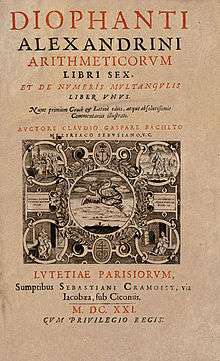Arithmetica

Arithmetica (Greek: Ἀριθμητικά) is an Ancient Greek text on mathematics written by the mathematician Diophantus in the 3rd century AD.[1] It is a collection of 130 algebraic problems giving numerical solutions of determinate equations (those with a unique solution) and indeterminate equations.
Equations in the book are called Diophantine equations. The method for solving these equations is known as Diophantine analysis. Most of the Arithmetica problems lead to quadratic equations. It was these equations which inspired Pierre de Fermat to propose Fermat's Last Theorem, scrawled in the margins of Fermat's copy of Arithmetica, which states that the equation , where , , and are non-zero integers, has no solution with greater than 2.
In Book 3, Diophantus solves problems of finding values which make two linear expressions simultaneously into squares or cubes. In book 4, he finds rational powers between given numbers. He also noticed that numbers of the form cannot be the sum of two squares. Diophantus also appears to know that every number can be written as the sum of four squares. If he did know this result (in the sense of having proved it as opposed to merely conjectured it), his doing so would be truly remarkable: even Fermat, who stated the result, failed to provide a proof of it and it was not settled until Joseph Louis Lagrange proved it using results due to Leonhard Euler.
Arithmetica was originally written in thirteen books, but the Greek manuscripts that survived to the present contain no more than six books.[2] In 1968, Fuat Sezgin found four previously unknown books of Arithmetica at the shrine of Imam Rezā in the holy Islamic city of Mashhad in northeastern Iran.[3] The four books are thought to have been translated from Greek to Arabic by Qusta ibn Luqa (820–912).[2] Norbert Schappacher has written:
[The four missing books] resurfaced around 1971 in the Astan Quds Library in Meshed (Iran) in a copy from 1198 AD. It was not catalogued under the name of Diophantus (but under that of Qust¸a ibn Luqa) because the librarian was apparently not able to read the main line of the cover page where Diophantus’s name appears in geometric Kufi calligraphy.[4]
Arithmetica became known to mathematicians in the Islamic world in the tenth century[5] when Abu'l-Wefa translated it into Arabic.[6]
See also
References
- ↑ "Diophantus of Alexandria (Greek mathematician)". Encyclopaedia Britannica. Retrieved 11 April 2013.
- 1 2 Magill, Frank N., ed. (1998). Dictionary of World Biography. 1. Salem Press. p. 362. ISBN 9781135457396.
- ↑ Hogendijk, Jan P. (1985). "Review of J. Sesiano, Books IV to VII of Diophantus' Arithmetica". Retrieved 2014-07-06.
Only six of the thirteen books of the Arithmetica of Diophantus (ca. A.D. 250) are extant in Greek. The remaining books were believed to be lost, until the recent discovery of a medieval Arabic translation of four of the remaining books in a manuscript in the Shrine Library in Meshed in Iran (see the catalogue [Gulchin-i Ma'ani 1971-1972, pp. 235-236]. The manuscript was discovered in 1968 by F. Sezgin).
- ↑ Schappacher, Norbert (April 2005). "Diophantus of Alexandria : a Text and its History" (PDF). p. 18. Retrieved 2015-10-09.
- ↑ Boyer, Carl B. (1991). "The Arabic Hegemony". A History of Mathematics (Second ed.). John Wiley & Sons, Inc. p. 234. ISBN 0-471-54397-7.
Note the omission of Diophantus and Pappus, authors who evidently were not at first known in Arabia, although the Diophantine Arithmetica became familiar before the end of the tenth century.
- ↑ Boyer, Carl B. (1991). "The Arabic Hegemony". A History of Mathematics (Second ed.). John Wiley & Sons, Inc. p. 239. ISBN 0-471-54397-7.
Abu'l-Wefa was a capable algebraist as well as a trigonometer. He commented on al-Khwarizmi's Algebra and translated from Greek one of the last great classics, the Arithmetica of Diophantus.
External links
Diophantus Alexandrinus, Pierre de Fermat, Claude Gaspard Bachet de Meziriac, Diophanti Alexandrini Arithmeticorum libri 6, et De numeris multangulis liber unus. Cum comm. C(laude) G(aspar) Bacheti et observationibus P(ierre) de Fermat. Acc. doctrinae analyticae inventum novum, coll. ex variis eiu. Tolosae 1670, doi:10.3931/e-rara-9423.